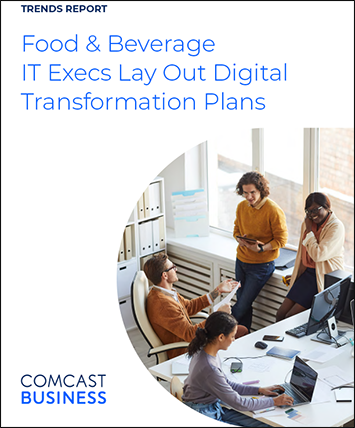Food & Beverage IT Execs Lay Out Digital Transformation Plans

Introduction
As they continue on their digital transformation journeys, IT executives at food and beverage companies are turning to technology to help them realize business goals that include upgrading the customer experience, growing their digital business, and making better use of analytics for decision-making.
In collaboration with Comcast Business, DemandScience recently conducted a survey of more than 200 IT decision-makers at food and beverage companies, including both full-service and fast-casual restaurants and other eateries. The results revealed IT decision-makers are also focused on streamlining operations, increasing resilience, improving health and safety, optimizing their supply chain, and improving business service delivery.
To help them realize those goals, IT leaders are turning to technologies such as mobile ordering and payment apps, omnichannel customer communications, Internet of Things (IoT) applications, as well as artificial intelligence (AI) and machine learning (ML) for data insights and automation.
But the IT execs recognize they face challenges in achieving their goals, including a misalignment between IT and business strategies along with overburdened IT systems, networks, and IT teams.
Obstacles to Digital Transformation
Digital transformation requires a heavy dose of technology and, in that regard, the respondents admit to facing some obstacles.
Chief among them is a misalignment between IT and business strategies, cited by 31% of respondents. That often reflects a situation where the business establishes a priority but may fail to align IT budget accordingly. If a goal is to improve the customer experience in restaurants, the IT budget needs to include funds for improving WiFi, menu boards, or ordering kiosks.
“Overburdened IT systems,” for example, can result from problems with “legacy network infrastructure”—both software and hardware—that is simply too outdated to keep up with modern workloads.
The same goes for obstacles like bandwidth constraints and “unreliable networks over public internet,” which are both symptoms of outdated legacy networks that are insufficient for a more digitally driven restaurant marketplace. Given such conditions, it shouldn’t be surprising that 24% of respondents report agility problems and 26% feel their IT teams are overworked.
Mobile Ordering & Payments Top Tech Plans
Implementing various technologies will play a significant role in helping food and beverage companies meet many of their priorities and overcome obstacles in their digital transformation journeys.
Asked which technologies they plan to implement, nearly half of all respondents (47%) said, “Mobile ordering and payment applications.” That maps directly to both the “upgrading the customer experience,” business priority, as well as “digital business growth.”
Mobile ordering also helps generate data for restaurants regarding customer preferences, frequency of visits, and the like. Data analytics can then be applied to improve customer experience, addressing another business priority of being a more data-based enterprise.
AI/ML and Omnichannel Communications
Indeed, nearly a third of respondents (32%) plan to implement AI and ML technologies in hopes of driving data insights and more automation efforts.
Forty percent of respondents said they’d be implementing “omnichannel customer communications.” As the name implies, this involves various ways to enable a multitude of customer touch points— including online ordering, mobile apps, self-order kiosks, and drive-thru—and to receive sales and marketing messages from restaurants.
Nearly a third of respondents are also planning to implement “contactless, frictionless transactions,” which include tap-to-pay, buy online, and pickup in store, and ordering through an app for curbside or in-store pickup.
Implementing IoT and Improving Security
Thirty percent of respondents are interested in IoT technologies, which can apply to business priorities including streamlining operations and optimizing the supply chain, among others. IoT sensors can help drive efficiencies in restaurant kitchens, whether by monitoring the temperature of refrigerators or automating fryer temperatures and operating times. In supply chains, IoT can be instrumental in monitoring the movement of goods and in providing accurate sourcing data.
Respondents seem to recognize that many of these technology efforts, such as omnichannel communications and IoT applications, have the potential to create new avenues for cybersecurity risks.
Not coincidentally, more than a third of respondents (37%) are planning to upgrade their cybersecurity solutions.
Cybersecurity Tops Investment List
When asked about technology investments planned for the future, responses indicated a continuation of investment priorities over the previous 12 months. On the top of that list is, again, cybersecurity solutions, cited by 43% of respondents. More than 40% of respondents have also recently invested in mobile ordering and payment applications as well as AI/ML solutions.
When asked to rank which IT infrastructure improvements were most important to their digital transformation strategies, flexible and scalable voice communications topped the list.
That voice topped the list may come as a surprise, given the digital path restaurants have set forward. It could represent an increased focus on takeout orders, spurred by the pandemic, and related customer service requirements.
Cloud-based services and compute capacity was the next ranked IT infrastructure improvement, followed closely by internet bandwidth and software-defined wide-area network (SD-WAN).
All three of these make sense for companies looking to ease the burden on internal IT staff and infrastructure while upgrading outdated networks. Adopting cloud-based applications, such as point-of-sale systems, accounting and enterprise resource planning (ERP) systems, reduces the amount of in-house infrastructure required in restaurants, and the support that comes with it. Similarly, cloud-based computing infrastructure can address the problem of overburdened IT systems while greatly improving agility, giving restaurants the ability to easily spin up new applications and services.
SD-WAN, meanwhile, is a far more flexible and effective way to provide wide-area bandwidth. It offers application-aware traffic routing and segmentation, enabling IT teams to ensure the most important applications always have the bandwidth they need.
It also enables IT to analyze traffic patterns more easily to better fine-tune their network. And it works with whatever WAN service is the best fit for each restaurant location, from dedicated Ethernet to 5G cellular and everything in between.
Managed services may prove to be a viable way for many food and beverage companies to overcome their digital transformation obstacles. Managed services can further ease the burden on IT groups with respect to managing the numerous technologies and services, including internal WiFi networks, wide-area services including SD-WAN, and security.
Customer Preferences Drive Tech Purchases
The desire to meet customer preferences is also driving a number of technology purchases, perhaps not surprising given respondents’ number one business priority was “upgrading the customer experience.”
The ability to personalize orders topped the list, cited by 42% of respondents. That ties back with the idea of leveraging AI/ ML to analyze past orders in order to offer personalized order suggestions.
Other customer preference drivers, all cited by 38% of respondents, include:
- Improved digital menu navigation, which is important given the heavy use of online menus during the pandemic
- In-restaurant entertainment, including TV and other activities—an especially important factor in fast casual and tavern-type establishments
- Paying for orders, with the trend being toward touchless systems
Technology that helps with delivery of orders was close behind, cited by 36% of respondents, as was free, reliable guest WiFi (35%). WiFi is becoming increasingly important as restaurants employ online menus that guests access via their mobile devices using a QR code, and to support back-of-the-house connectivity.
Food and beverage firms are also making use of data to drive more effective engagement with customers. At least half of respondents are using data to:
- Facilitate menu suggestions
- Drive customer-specific
- Power rewards programs
It’s all tied together: Analytics helps improve the customer experience and improving the customer experience leads to digital business growth.
Transformation Requires a Sound Tech Foundation
Given their reliance on technology to meet their digital transformation goals, food and beverage companies would do well to ensure they have a sound IT infrastructure in place in all locations. Legacy networks based on older IT architectures are not likely to be able to meet the demands of emerging digital technologies.
Robust WiFi networks are now a must throughout the restaurant. Besides meeting guest expectations, fast, reliable WiFi networks are required in the back end of the restaurant to meet demands of latency sensitive technology such as IoT monitoring and control solutions.
As restaurants increasingly adopt cloud-based solutions, they will also need a sound WAN strategy. Chains with multiple locations may find SD-WAN makes good sense. With SD-WAN, network control functions are abstracted from the underlying physical network, allowing restaurants to choose the WAN service that matches the requirements of each application and location while also improving reliability.
Configuring backup links for each connection becomes a simpler task, such as using internet or cellular wireless connections, including emerging 5G services, to back up primary links.
Cybersecurity services are also a must, as no business today is immune from a variety of threats, such as phishing attacks, malware, ransomware, and more.
Managed services may well be the best way forward for many food and beverage companies. They help address numerous technology obstacles, including overburdened IT systems and teams, and reliance on legacy networks and infrastructure. With managed services, much of the day-to-day responsibility shifts to the service provider, leaving internal IT teams with more time to focus on strategic transformation projects.
Restaurant IT teams push their business forward with digital-first experiences
Locked Content
Click on the button below to get access
Unlock NowOr sign in to access all content on Comcast Business Community
Learn how Comcast Business can help
keep you ready for what's next.











